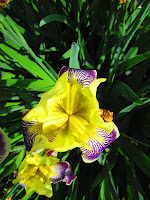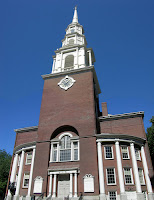

My next stop was the birthplace of JFK in Brookline. I was expecting a guided tour but that weekend they had an open house to celebrate his birthday. The house actually wasn't all that big but I got to see the room that he was born in which was pretty neat.
He only lived in the house until he was about 3. In the backyard they had cupcakes and lemonade and also some photos of JFK through his life which was enjoyable.
Then it was time to hop on the subway (since I was tired of dealing with Boston traffic). My first stop was in Cambridge, home of Harvard University. Actually my destination there was the Longfellow house.

 It actually is famous for 2 reasons. It was the home of Henry W. Longfellow, one of the world’s foremost 19th century poets. The
house also served as headquarters for General George Washington during
the Siege of Boston, July 1775 - April 1776. The house wasn't open for tours but the grounds were absolutely gorgeous. The flowers were all in full bloom and were stunning.
It actually is famous for 2 reasons. It was the home of Henry W. Longfellow, one of the world’s foremost 19th century poets. The
house also served as headquarters for General George Washington during
the Siege of Boston, July 1775 - April 1776. The house wasn't open for tours but the grounds were absolutely gorgeous. The flowers were all in full bloom and were stunning.
Since I was in Cambridge I decided to walk over to Harvard and check out the business school. During my MBA, every class utilized Harvard Business Review cases so it was nice to stand on the hallowed, ivy covered grounds.
 |
| I made it to Harvard! |

I hopped back on the subway and headed into Beacon Hill to the Boston African American National Historic Site. There's a walking tour that goes all through Beacon Hill. It is known for its narrow streets and brick sidewalks.

 What was weird was that there was literally no traffic. Cars were lining the sidewalks but I only saw a car or two actually driving through the streets. I guess no one wants to lose their parking spot. It is a very picturesque neighborhood and with the shaded streets, a nice walk on a hot day. I was hungry after all that hilly walking so I stopped at UBurger next to Boston Common and has a delicious lunch. Fortified, I set off on the Freedom Trail. It is a great walking tour through downtown Boston. The best part is that all you have to do is follow a brick path on the sidewalk for 2.5 miles and it takes you past 16 significant historic sites. Markers along the way explain events, graveyards, notable churches
and other buildings. I wish every city had such a thing. For more information check out their website: http://www.cityofboston.gov/freedomtrail/default.asp
What was weird was that there was literally no traffic. Cars were lining the sidewalks but I only saw a car or two actually driving through the streets. I guess no one wants to lose their parking spot. It is a very picturesque neighborhood and with the shaded streets, a nice walk on a hot day. I was hungry after all that hilly walking so I stopped at UBurger next to Boston Common and has a delicious lunch. Fortified, I set off on the Freedom Trail. It is a great walking tour through downtown Boston. The best part is that all you have to do is follow a brick path on the sidewalk for 2.5 miles and it takes you past 16 significant historic sites. Markers along the way explain events, graveyards, notable churches
and other buildings. I wish every city had such a thing. For more information check out their website: http://www.cityofboston.gov/freedomtrail/default.aspCome along with me and walk the trail!
Boston Common: The starting point of the Freedom Trail, Boston Common is the oldest park in the country. It was funny to see old images of cattle grazing on the common. Public hangings
also took place here. British troops camped on Boston Common prior to the
Revolution.
Massachusetts
State House: This looms over the Common and is gorgeous. The dome is the focal point and it is covered by 23 karat gold which was added to prevent leaks
into the State House.
Robert Gould Shaw Memorial: Across from the State House is this memorial to the group of men who were among the first African Americans to fight in the Civil War.
Park Street Church: A cool fact I learned here: The church is located at Brimstone Corner which may have received its name because
preachers spoke of fire and brimstone in Hell to their congregation or
because sulfur was stored in the basement of the church.
Granary Burying
Ground: The third oldest burying ground in Boston. Among it most famous "residents" are Samuel Adams and John Hancock as well as Paul Revere.
King's Chapel and
Burying Ground: This is the oldest burying place in Boston. So named because King James II ordered an Anglican parish to be built in Boston to insure the presence of the Church of England in America.
The interior of the church was actually really cool. The pews were set
up like little booths. Although it didn't make sense because if you sat
facing the other way, you couldn't see the preacher.
First Public
School Site and Ben Franklin Statue: Benjamin Franklin overlooks the former site of
Boston Latin School which Franklin, Samuel Adams, and John Hancock once
attended.
My favorite part of this site was the statue of a donkey. It signifies the Democratic Party. In front of
the donkey are 2 bronze footprints where you can "stand in opposition".
There's also a plaque explaining its origin as
the party's symbol which is very interesting: It's history dates back to 1828
when Andrew Jackson established the Democratic party and ran for
president using the populist slogan, "Let the people rule." His
opponents thought him silly and labeled him a "jackass". Jackson,
however, picked up on their name calling and turned it to his own
advantage by using the donkey on his campaign posters. Over the
years this donkey had become the accepted symbol of the Democratic
party.
Former Site of the
Old Corner Bookstore: Many famous books were published here, including The Scarlet Letter, Walden, and the Atlantic Monthly magazine.

















No comments:
Post a Comment